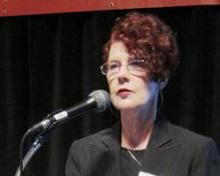NEW YORK – Behavioral therapy is generally a more effective way than prescribing medications to help children with trichotillomania – especially if the symptoms are not too severe.
While adults with the disorder seem to improve with some antidepressants and neuroleptics, children and teens do not reap nearly the same benefit, Dr. Barbara J. Coffey said at a psychopharmacology update held by the American Academy of Child and Adolescent Psychiatry.
"A lovely randomized study showed that even little children did very well with behavioral therapy," said Dr. Coffey, director of the Institute for Tourette and Tic Disorders at New York University Langone Medical Center. "The concern was that they might not respond as well as [with] older children but, in fact, they did – and maybe even did a little bit better."
Treatment decisions should be based on symptom severity, she said. A couple of scales have been created to assess that in youngsters, including the Trichotillomania Scale for Children. It characterizes symptoms according to both distress and impairment (interference with relationships, school, and grooming routines) and severity (frequency, duration, number of hairs pulled, and controllability).
The Massachusetts General Hospital Hairpulling Scale is a seven-item self-report with a severity rating of 0-4. The Milwaukee Inventory for Styles of Trichotillomania–Child Version is another self-report, this one containing 36 items. The U.S. National Institute of Mental Health Trichotillomania Severity Scale, however, might be the most useful for small children. This tool, which contains a semistructured interview, also is used as an assessment tool in many clinical trials.
For children with mild symptoms, without distress or impairment, "simple behavioral interventions and monitoring may be all that’s needed," Dr. Coffey said.
This includes using strategies that make it just a little harder to physically grasp and pull hairs, such as placing small Band-Aids on fingertips, wearing gloves, or putting on a hat. Parents can help by making sure that the interventions are consistent and giving lots of praise when the child abstains from pulling.
For moderate symptoms, habit reversal therapy is a better choice. "The first few days of treatment are designed to help the child develop an awareness of the circumstances and triggers for pulling, and the sensations or urges that are involved," she said. "We are trying to develop an awareness of the premonitory urge."
The second phase of therapy focuses on developing competing behaviors. "We want them to engage in a behavior that is physically incompatible with pulling – like making a fist, playing with a stress ball, or sitting on their hands. They’re instructed to do this behavior for 1 full minute, so they can learn to tolerate the uncomfortable sensation that drives them to pull."
If the symptoms do not improve, or if they get worse, medication might be looked at as an add-on treatment. The first choice is usually an antidepressant or a neuroleptic, Dr. Coffey said.
Clomipramine probably have a little more positive data behind it than do selective serotonin reuptake inhibitors (SSRIs). A 2007 meta-analysis examined seven studies that included 157 adults who were treated with clomipramine, SSRIs, and behavioral interventions. "Habit reversal therapy was superior to clomipramine. Clomipramine was superior to placebo and to SSRIs. But SSRIs were not superior to placebo. So our usual toolbox of medications that we might use for an obsessive compulsive disorder failed to show efficacy."
Since behavioral therapy is more effective than medical therapy, it is very important to keep these strategies on board when adding any drugs, Dr. Coffey stressed.
N-acetylcysteine, a glutamate modulator, also is being used as an add-on treatment. A few studies have suggested a benefit, but the most recent, published last year, was "a big disappointment," she said. That study randomized 39 children aged 8-17 years to the compound or to placebo for 12 weeks (J. Am Acad. Child Adolesc. Psychiatry 2013;52:231-40).
"The good news is that both groups improved, and there were no real adverse effects," she said. "The bad news is that while both groups improved, there was no significant difference between the active and the placebo groups."
N-acetylcysteine reduces glutamate in glial cells and synapses, and promotes the production of glutathione, the body’s most powerful antioxidant. In adults, it’s been shown to benefit people who have addictions to cocaine and other drugs that activate opioid receptors.
"I still do use it sometimes," Dr. Coffey said. "I believe there are some children who are helped by it." She said the medication is over the counter and has virtually no side effects.


